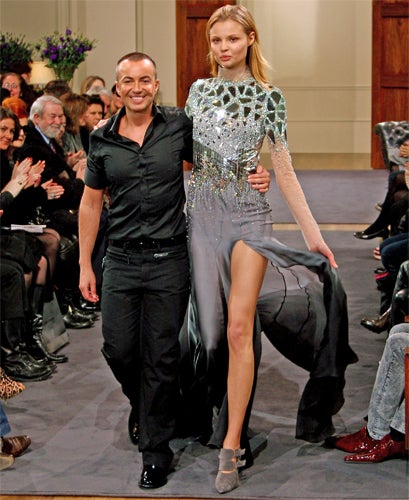Designer says plus-size models are 'a joke'

Your support helps us to tell the story
From reproductive rights to climate change to Big Tech, The Independent is on the ground when the story is developing. Whether it's investigating the financials of Elon Musk's pro-Trump PAC or producing our latest documentary, 'The A Word', which shines a light on the American women fighting for reproductive rights, we know how important it is to parse out the facts from the messaging.
At such a critical moment in US history, we need reporters on the ground. Your donation allows us to keep sending journalists to speak to both sides of the story.
The Independent is trusted by Americans across the entire political spectrum. And unlike many other quality news outlets, we choose not to lock Americans out of our reporting and analysis with paywalls. We believe quality journalism should be available to everyone, paid for by those who can afford it.
Your support makes all the difference.It is a debate that will run and run but, where the fashion industry is concerned, clearly size does matter.
In remarks that will come as a disappointment to campaigners for diversity in fashion, the designer Julien Macdonald has dismissed the recent rise of plus-size models, insisting that "a catwalk model is a size six to eight". In an interview, the British designer, who is also a judge on the reality TV show Britain's Next Top Model, said of the competition: "This is a serious show. You can't have a plus-size girl winning – it makes it a joke."
Macdonald's comments may be at odds with the general turnaround in fashion, but the Welsh designer knows how to generate helpful controversy: his spring/summer 2007 collection provoked animal rights groups who felt it relied too heavily on fur, and his search for the country's Next Top Model will no doubt get a boost in ratings.
His remarks to Wales on Sunday come after a year which has seen several high-profile magazines electing to use plus-size models, as well as designers booking bigger models to appear in their catwalk shows.
"A programme like Britain's Next Top Model could have pushed the boundaries a little further by recognising the shift in thinking and looking for a size 10 instead," said the fashion commentator Caryn Franklin, co-founder of All Walks Beyond the Catwalk, which campaigns for diversity in modelling. "There's big money to be made by models with curves, as everyone but Julien knows."
Since the British Fashion Council's 2007 Model Health Enquiry, the issue has never been far from the headlines, but the past 12 months have seen good progress in bringing diversity to the glossies. In June 2009, the editor of British Vogue, Alexandra Shulman, wrote a letter to designers asking them to adjust their sizings because her magazine had been photoshopping models to look bigger, after "minuscule sizes" forced them to hire models with "jutting bones and no breasts or hips".
Two months later, American Glamour printed a picture of size 12 Lizzie Miller, in which a roll of stomach was clearly visible; then Germany's most popular women's magazine, Brigitte, pledged only to use real women in its shoots; and in January 2010 V ran a "size issue", in which the photographer Terry Richardson shot the sample-sized Jacquelyn Jablonski next to the size 16 supermodel Crystal Renn.
"The fashion world needs to change," Renn told The Independent. "Women on the street don't relate to all this talk of plus sizes, and it creates an "us and them" mentality within the industry, which leads to comments like the ones Julien Macdonald has made."
But Katie Grand, the editor of Love magazine, which used a naked Beth Ditto on its inaugural cover, said: "There are plenty of celebrities and models who are extremely successful financially and have great credibility, who are not necessarily 'sample size'. It is possible to be a successful model without ideal clothing measurements."
Join our commenting forum
Join thought-provoking conversations, follow other Independent readers and see their replies
Comments